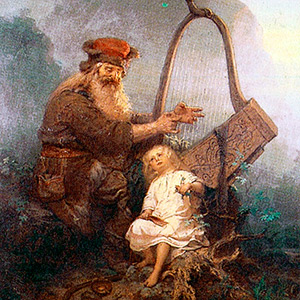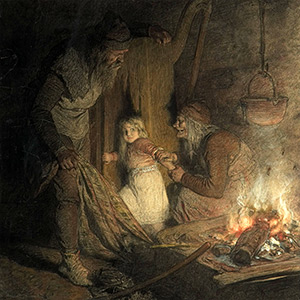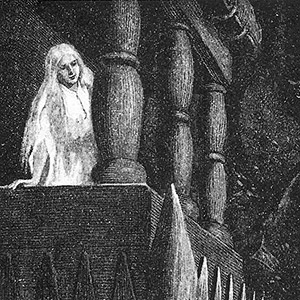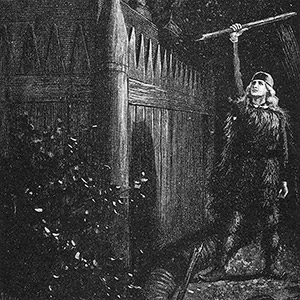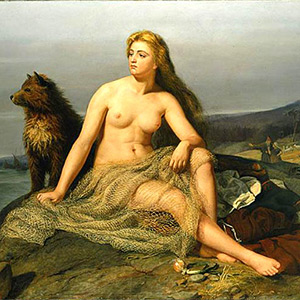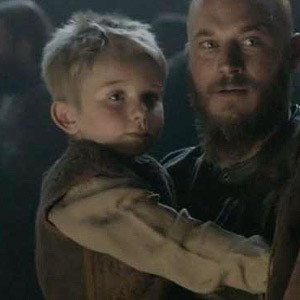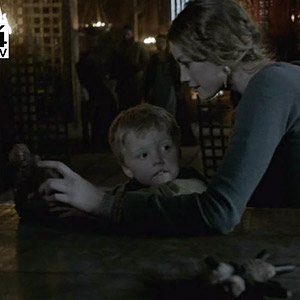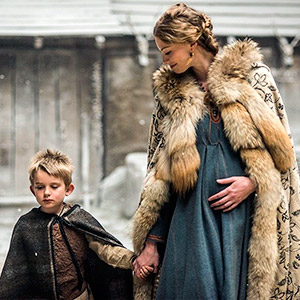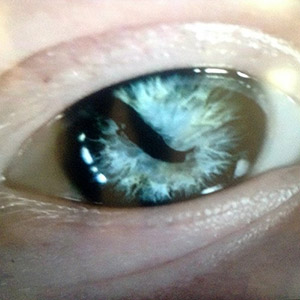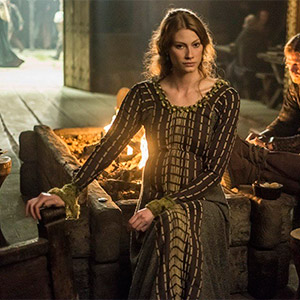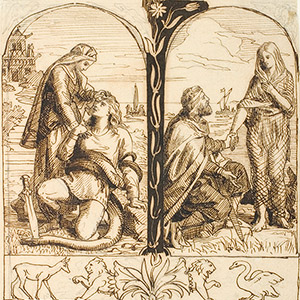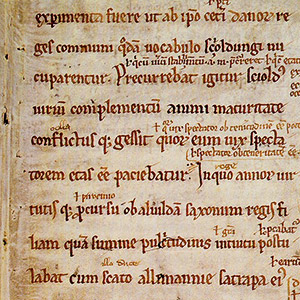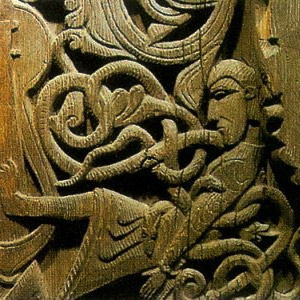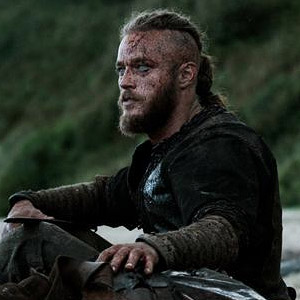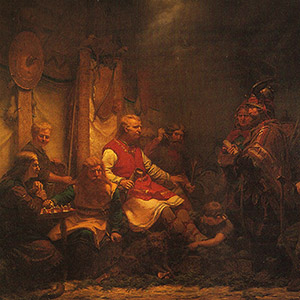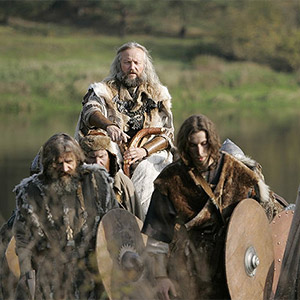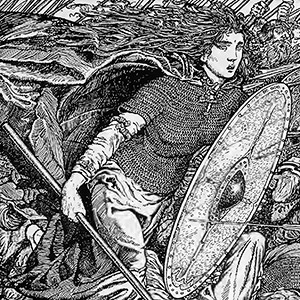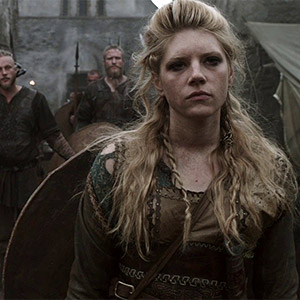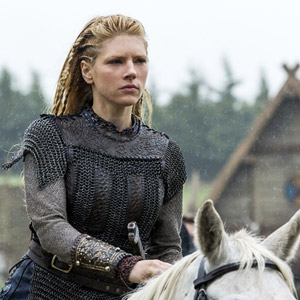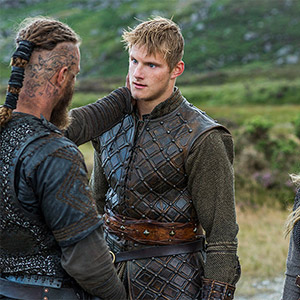|
|
|||||||||||||||||||||||||||||||||
History Channel will be launching the third season of the series Vikings this week. At one point during the first season I stopped following the show, after being provoked by an absurd episode the where Vikings travelled to a Christian stave church in Uppsala (filmed on top of a tall fjord in Gudvangen) to sacrifice human beings in a ceremony portrayed as a common Norse custom. The producers clearly felt an excessive need to draw in violence and sexual practices where it didn’t belong (heavily based on extreme and disputed accounts such as that of the single Arab traveller Ahmad ibn Fadlan, rather than on the saga literature itself), and promoting caricatures of the stereotypical Viking (which like I mentioned in another post may reflect as little as <1% of the Scandinavian population in the Viking age). Granted, this is not particularly surprising as we are talking about a television production – even one that is promoted by someone claiming the name "History Channel". Nevertheless, I decided to pick up the threads again and gave it another chance when the second season had come out last year. After all, we don’t see big productions made about the Viking culture too often, especially since we don’t seem to want to take charge of them ourselves. Also, there are many good things to say about the Vikings series, and it actually contains less graphic and grotesque violence scenes than certain other comparable series (which in fact was and is my main problem with series such as Rome, Game of Thrones, and Spartacus etc.). I eventually started looking forward to each new episode of the second season coming out, and now I am excited about the third! I do, however, take the story conveyed with a large pinch (shovel?) of salt, and I committed myself to read up on the relevant saga literature. Historical TV productions are educative in their own way and certainly do spark valuable interest in the relevant cultures of their portrayal, but I feel strongly that we should be careful not to let them leach out on the original sources and become the new references for knowledge. With this regard I would like to pass on a detailed summary of that which I've ploughed through (and now translated to English), primarily the old Icelandic Ragnars saga loðbrókar ok sona hans from Fornaldarsaga (1) but also Þáttr af Ragnars sonum from Book of Haukr (2), Danish saga om Ragnar Lodbrog in two parts from book IX in Saxo Grammaticus’ Gesta Danorum ("Deeds of the Danes") (3,4), and other related sagas elaborating the stories about the same man, who is a partly fictional and partly historical character believed to have lived in the 800s, possibly being born between 750-794.. 
But first, there is one thing that needs to be said: The other day I noticed someone referring to Ragnar's wife as "Mrs. Lothbrok". That gave me a slight desire to smack them over the head with the aforementioned shovel. ^^ Norse name practice is characterized by people not taking their spouse's name upon marriage. A man of mine would never have my last name, unless he changed his gender (as well as changing fathers for that matter). And if I fancied wearing leather pants to the point where I ended up getting Loðbrók as an epithets, it would still not impact his name (unless he also had a special relationship to leather pants). Below you will find the summary/short version (that is, as short as it gets without missing any points) where I summarize the sagas about Ragnarr Loðbrók in my own words. The sagas mention many different stories and there are some inconsistencies in the various sources, but I will make this version as complete as possible, and show you the sources along the way. And if you happen to be above averagely interested and actually bear to read this though, I have tried to make it a bit more readable for you by dividing the text into relevant sections. Let me begin with Áslaug (Kráka/The Crow), and take it from there. ➛ About Heimir og Áslaug Áslaug is mentioned both in Skáldskaparmál (5) and in the Völsungs saga (6) in addition to Ragnars saga loðbrókar ok sona hans (1), and is in many ways the central character of the latter. The story begins when she is three winters old, and tells us that her parents (the famous shieldmaiden Brynhildr and Sigurðr Fávnisbani who got his name after killing the dragon Fávni), are dead. Her foster father (and grandfather) Heimir knows that there are people searching for the little girl, and to protect her he decides to run away. He hides her along with his valuables, inside a harp of gold that was made so that he could open it. He arrives at a farm in Norwegian Spangereid, where the farmer Áki and his wife Gríma live, and asks them for food and shelter. Gríma is home alone and receives him well, but when he has settled for the night and her husband comes home she persuades him to kill the guest in his sleep, because she had gotten a glimpse of part of the treasure which stuck out of the harp, and wanted it for herself. At first, Áki did not want to do this, but Kráka convinced him by threatening to take the guest as her husband and chase Áki from the farm. He then does as she wishes and sends Heimir to Hel, and when the two open the harp (in their own clumsy way) Áslaug appears. They brood over what to do with the child, since she is more beautiful than both of them, and no one will believe that she is their daughter. Gríma makes a cunning plan to shave the little girls' head and cover her hair with tar so that is won't grow back, and let her do all the hard work on the farm. They call her Kráka (The Crow), after Grímas mother (1).
➛ Þóra Borgarhjörtr (Town-Hart) Herruðrdóttir We then hear about the rich Earl Herruðr, who has a young daughter named Þóra. She was nicknamed Borgarhjörtr (Town-Hart) because she was as beautiful among women as a deer is among the animals. Her father loved her so much that he brought her a gift every day, and there was the day that he brought her a gold colored lindworm (in Bósa saga ok Herrauðs (7) one can read about how he and his brother found this worm in a vulture egg when he rescued the woman Hleiðr, who later became Þóras mother). Þóra kept the worm in a box with a gold bottom, and as it grew, so grew the gold too. The worm grew into a serpent, and gradually became so big that it eventually encircled the entire house she lived in, biting its tail like the Midgardr serpent that coils around the earth. This lead to no man daring to come to her, except those who had to bring food for the serpent - as it ate an entire bull every day. The Earl naturally found the situation to be problematic, and sent out word that he who could kill the serpent would marry his daughter, and Þóra would get the gold that lay beneath it as her dowry (1). ➛ Ragnar kills the serpent and gets Þóra (spoiler alert?) At the same time there was a king named Sigurðr Hringr who ruled over Denmark. He had a young son named Ragnar, who was big and handsome and good with his kinsmen, but quite grim towards his enemies. He had acquired himself an army of men and warships, and came to be a famous warrior. He had heard about the words of Herruðr, but pretended he did not care. He made himself a set of strange clothes, namely leather pants and a leather jacket, which he boiled in pitch and dug down in the earth. One summer he came ashore at Gautland near Herruðs land, and stayed there for the night. Early in the morning he put on the aforementioned leather clothes and rolled around in the sand with them, took the nails out of his spear and went towards the fence that surrounded Þóras house. He struck the worm twice, and the head of his spear stuck in the serpent's body. The serpent's blood spurted over Ragnar, but his clothes protected him (against this seemingly toxic blood). The people in the house were awoken by the uproar, and Þóra came out and saw Ragnar heading away. She asked him who he was, and he sang a verse that revealed that he was 15 winters old and told about his errand to kill the serpent and save her. He disappeared suddenly and she was unsure if he had been a human or something else, due to his sheer size (1).
Þóra went back inside and went to sleep, and when the men awoke the next day and saw the dead serpent she advised her father to call all men to a big þing (assembly) with mandatory attendance, where the one who had the spear shaft which belonged to the spearhead found in the serpent would get his reward as deserved. The word reached Ragnar's ship, and him and his men went to the meeting, but kept themselves at a distance. Having measured the spearhead against everyone spear shafts the Earl eventually came forward to Ragnar, and he got Þóra in sort of a genuine Viking Cinderella way, and there was a grand wedding. They went home to Denmark and ruled there, and Ragnar loved his wife very deeply. They had two sons together, Eirekr and Agnarr, who were both handsome and big as their father, and good in sport. But after a while Þóra became sick, and died. Ragnar took this loss so heavily that he gave up his rule of the kingdom and handed it over to be controlled by other men along with his sons. He went out travelling and raiding, and continued to make victory wherever he went (1). ➛ About Ragnar and Kráka One summer Ragnar sailed his ships to Norway to meet friends and relatives, he came to shore by Spangereid. Some of the men went ashore in the morning to bake bread, and met Gríma who said that Kráka could help them with it. Kráka (or Áslaug) had seen the ships, and washed herself even though she was not allowed to. When the men saw her, they were very surprised by her beauty, with beautiful hair that reached down to the ground around her. The men were so preoccupied by her that they burnt the bread. When they came back and Ragnar heard this, he refused to believe that this woman could be as beautiful Þóra was. He asked her to come to meet him, and she was to be neither dressed nor naked, full nor hungry, lonely nor with companions. Kráka got the message, and sent the messengers alone back to the ship. The morning after she came walking to Ragnar woven into a fishnet and with her long hair hanging around her. She was eating an onion as she walked, and had a dog at her side. She spoke a poem to Ragnar and he asked her to come on board his ship (1).
Her dog bit Ragnar in his hand, and his men killed it. She then asked to leave, but Ragnar had gotten a good impression of her and wanted her to be with him. She said that he had to go on the journey he had planned, and come back for her later. Then he could see if he still wanted her. Ragnar then offered her Þóras old chemise, which was covered in golden seams, but Kráka dared not accept it, and told about her life as a peasant girl in dirty conditions. Ragnar then did as she said, and when he came back Kráka left the farmer and Gríma. But before she left she cursed them and revealed that she knew about what they had done to her foster father Heimir when she was a child. Ragnar received her well, and the same evening as they had sailed away together he wanted them to sleep together. She asked for a wedding in his kingdom first, and she got her wish. But when he tried to get her into bed again on the wedding night, she sang a verse that said that they would stay together for three nights before they had intercourse, and if she did not get to decide this they would conceive a son who was boneless. Ragnar did not care about this and did as he pleased, against her will (1). ➛ About Ragnar's sons Time passed and the two lived together well. But then Kráka became unwell, and gave birth to a baby boy named Ívarr who had cartilage instead of bones. He could not walk, but he was large, handsome and wise, and let himself be carried by his men. They also had the sons Björn Járnsíða (Ironside), Hvítserkr (Whiteshirt) and Rögnvaldr. Ragnar's oldest sons Eirekr and Agnarr had become big warriors and did well, and the four youngest sons eventually wanted, led by Ívarr, to do the same. They started off with men and ships which they had gotten from their father, and were superior in battle wherever they travelled. Ívarr felt they needed a challenge, and suggested to his brothers that they'd go to Hviteby, where many before them had tried to go without victory. They headed there, and Ívarr was carried on a shield, while the youngest brother Rögnvaldr was left to watch the ships. Nevertheless it ended by him going after his big brothers to fight, and he fell in battle. But the other sons of Ragnar conquered Hviteby and the wealth that was there, and burned down the city before they sailed away (1). In the second and shorter version of Ragnar's saga from Hauksbók (2), more emphasis is put on the fact that Ragnar's sons wanted to surpass their father and become more famous than him, which he disliked.
➛ King Eysteinn and Uppsala Eysteinn was a king who ruled in Svíþjóð (Sweden), he was malicious but wise, was married and had a daughter named Ingibjörg. She was the fairest of all women. Eysteinn was known for his blóts (sacramental feasts in celebration of the Gods), and in Uppsala there was once the biggest blót that was ever held in Scandinavia. There was a cow there, Sibilja, which was worshiped (yes, a cow), and she protected the Swedish King with her roars, noises and diabolical force. Ragnar was visiting with King Eysteinn and when they were feasting he was served a drink by Ingibjörg. Ragnar's men saw how beautiful the princess was and told Ragnar that he could not do other than to ask for her hand and divorce from the farmer's daughter he was married to (Kráka). He decided to do so, and an agreement of marriage was made. On the way through a forest on the journey home Ragnar asked all his men to remain silent about this agreement, and said that anyone who revealed it would pay with his life (1). But when they came back home Kráka sat down on Ragnar's thigh and put her hands around his neck, and asked what news he had to tell her. Ragnar denied that he was hiding anything, and when they went to bed that evening Kráka told him that she knew about his plans ("that I call news, that a king takes a wife, although some would say that he has one already"). She also revealed her identity as a princess and the daughter of the famous Brynhildr and Sigurðr Fávnisbane. She was with child, and predicted that she would give birth to a son who had mark of the serpent in his eye, and that if it happened, he was not to go back to Sweden - otherwise he could do as he wished. The boy was later born with a mark in his eye resembling a serpent, and was called Sigurðr ormr í auga (snake-in-the-eye). Ragnar stayed with Áslaug and her heritage was made known to all (1).
➛ About Eirekr og Agnarr When Ragnar did not show up in Sweden as planned, King Eysteinn and his daughter were insulted, and the friendship between the kings was over. Eirekr and Agnarr then decided to collect as many warriors as they could, to go there to ravage. Prior to the journey they got some bad omens, but decided to go anyway. King Eysteinn met them with an army three times as great, not to mention Sibilja, who killed many men with her horns, and made sounds that turned the warriors against each other and made them fight among themselves. The two brothers were the only ones who withstood, and they fought long with great honor, but eventually Agnarr fell and Eirekr was captured. He was offered mercy, and in addition to marry the king's daughter. But he sang a verse where he declined, and said that he had no mother who would mourn him. He asked for mercy for his men, but said that he himself was ready to die. But first he sent an armring with his men, requesting that it should be brought to his stepmother Áslaug. He knew that she would then grieve, and tell her sons what had happened (1). When the messengers returned to Denmark Ragnar was away at a meeting, and his younger sons were gone raiding. They brought the news to Áslaug, and spoke to each other through a series of poems. She then shed a tear, and it was colored like blood and hard as hail. No one had ever seen her cry before, and none were ever to see it again. When her sons came home, she went to talk with them, and with her she had Sigurðr Snake-Eye, who had become three winters old. They first told her about Rögnvaldrs fall, and then she told them of the death of their stepbrothers. She impelled them to go to Sweden to avenge them, and said that she would help with anything she could. But Ívarr took the word for his brothers, and said that he refused to go to Sweden and fight against the sorcery that was there. There were some harsh words exchanged between them. Then little Sigurðr broke out in words of a poem, and said that he could not speak on behalf of the others, but that he would go with her, and overcome Eysteinn. Áslaug thought very well of her youngest son, and the elder brothers began to change their minds. Björn and Hvítserkr said that they could well remember their stepbrothers, and now they wanted to chop the ice that lay around their ships that had been frozen in, and sail out to avenge them. Ívarr then took the word, and said that he had also changed his mind. He wanted to join, because his head could lead the revenge, even though his hand could not (1).
They then started supplying the ships and collecting men, and this process went very fast. After one week they had five ships on behalf of Sigurðr, Hvitserk and Björn had collected thirteen ships, Áslaug ten and Ívarr ten. Ívarr had also sent an army by foot. Áslaug went with this army, and she changed her name to Randalin (1). According to the version in Hauksbók (2) there were 1500 warriors on foot and Randalin wore warrior clothing and was their leader. The warriors went both ways and met at the agreed place in Sweden. There they killed everything and everyone in front of them, in a barbaric manner. King Eysteinn collected as many men as he could find to meet this army (1). They took Sibilja, whose noise and sorcery again attempted to overpower the enemy. But Ívarr asked everyone to make as much noise as they could, with loud cries and clinging of weapons, to drown the noise of the cow, and he asked to be carried in front of the army and thrown against her. He shot her in both eyes with arrows from his bow, and when they threw him he was light as a feather. But when he landed on her back, he was as heavy as a rock, and broke every bone in her and that became her death. King Eysteinn fell, and the brothers had victory. They then gave mercy to those who were left, and Randalin went home with some of the warriors while her sons would to fare to the Southern Kingdom to find some greater power to fight against. Little Sigurðr went with them (1). Regarding King Eysteinn and his kingdom in Sweden there is a significant difference between the two versions of Ragnar's saga that is worth mentioning. In the version from Hauksbók Ragnar's sons went raiding against their fathers will, and took his "tax land". In this version, King Eystein was a king under Ragnar, whom he had appointed to govern Uppsala and protect it against his sons (2). After Eysteinns fall the sons of Ragnar went to a castle named Vífilsborg named after the chieftain who ruled there (1). He and most of his army was not at home, but the brothers still did not succeed in taking over the castle, even though they camped there and tried for half a month. The men who were in the citadel teased and taunted them, and showed off what wealth they had over the castle wall. This affected Ívarr so badly that he became very sick, but then he gathered his brothers and all the wisest men to put together a plan. They snuck out into the woods at night to fetch firewood and burn the chalice in the castle walls. After doing this, they attacked the wall with trebuchets and broke it up, plundered and ravaged, and travelled on. When they had been through practically every fortress and castle throughout the Southern Kingdom, and had become so famous that there was not so much as a child who did not know about them, they decided not to stop until they had reached Rome. These plans were however changed after they met an old wanderer, who told them that the distance there was so long that he had worn out two pairs of iron shoes on his way.
➛ King Ragnar's death in England All of this time Ragnar sat at home in his kingdom without knowing where his sons or wife has gone. He heard nothing but others boasting on about them and how no one could compete with them. Ragnar thus began to wonder what he could do to surpass his sons, and ordered the building of two ships that were so large that there were none equal. People around the whole kingdom were asked to arm themselves, and understood that he was planning some sort of big overseas journey. Rumors spread around the neighboring countries, and both king and layman feared what would happen. Then Randalin came home, and Ragnar told her that he was thinking about going to England. Randalin thought it was careless to travel with only two ships, and she also believed that it was wrong to use knarrs (trading vessels) instead of longships if one was to go to England. Ragnar still wanted to do it, because a victory would not be regarded as spectacular if he had many ships. When it was time for parting, Randalin said that she wanted to repay him for the chemise he had given her when they met, and she would do so with a tunic woven by gray hairs, a costume that was divine and blessed by the Gods. It was very clear that the farewell affected her deeply (1). Both Ragnar's ships were wrecked on the way to England, but the men managed to come ashore with their weapons. The King who ruled over England at the time was called Ella, and he had heard about Ragnar's arrival and asked all the men to get ready for battle, but that they were not to kill Ragnar, for he had sons who would never let them get peace. When the armies met it was clear that Ragnar was outnumbered. He had no armor, but he had a helmet, and was dressed in the clothes that he had received from Randalin, and he had the spear that he had used when he killed the worm to get Þóra. With these things, he was the only one on his side who survived the battle, and he was captured by King Ella's men. When he was taken into captivity he refused to talk or tell anyone who he was, and Ella punished him by throwing him in a snake pit, where he sat very long. But the worms did not bite him, before Ella asked them to strip him of his outer garments, and then they were soon all over him. Before he died, he sang two verses, including "never I thought that snakes would be my ending; often a man encounters, what he least expects" (1). In the older skaldic poem Krákumál from the 1100s (8), there is a much longer text with 29 verses of 10 lines each. It does not match the two verses from the saga and provides descriptions of many more events and battles that probably have roots in earlier accounts of Ragnar, that are now lost. It is written in the first person and concerns Ragnar's memories of his life, which he reads as the snakes are chomping at him, and his desire to be picked up by Valkyries and brought to Oðins halls. The poem ends with "læjandi skalk deyja" (with laughter shall I die).
➛ Ragnar's sons and King Ella Ragnar's corpse was carried away, and King Ella was very worried about how his sons would take these news. They were however on their way home again after their own long journeys and were struggling to find food on their way, because everything and everyone fled before them, and took their riches with them as they escaped. They came all the way home to the Danish dominions before the news of their father's death reached them. When Ella's messengers arrived and gave them the news they all responded in very powerful ways. Björn held on to his spear-shaft to firmly that his hands left marks in it and trembled so hard that it broke in two. Hvítserkr, who had been playing tafl when the news arrived, held so hard onto the piece that blood was running from his nails and Sigurðr did not notice that the knife he had been holding in his hand cut him all the way into the bone. Ívarr was on his part mostly preoccupied by inquiring carefully about what had happened, and was swollen by the anger that he kept inside his chest. But he made is so that the messengers could travel safely back to Ella, where they told the King of the various reactions of the brothers. Based on this Ella told his men that he feared the most for Ívarr. However, back home in Denmark Ívarr protested his brothers’ wishes for revenge, and said that he would rather let King Ella give penance for the murder of Ragnar. He would therefore not give his support or his ships to the revenge mission the brothers were planning, with the exception of one ship. The other brothers nevertheless collected all the men they could, and they travelled together to England. Ívarr came with them, but did not join the battle, which ended by his brothers having to flee. But Ívarr wished to be left with King Ella and see what penance he would give him. The brothers parted. Ívarr made a deal with the king that he would get a piece of land in England that was only as big as a cowhide could cover, and swore then that they should not contend with each other. But cleverly, and by making long straps of leather's from the various parts of the hide, he got a very large area, where he built a large and famous castle that was called Lundúnaborg (London town). He got many friends in England, and provided them as well as the King with his good advice and assistance. But it was all part of a cunning plan, and he bought the most powerful men in the country so that they would not assist King Ella, while at the same time he sent for his brothers to bring such a large and invincible army as they could muster (some sources claim that this was what was later known as "the great Heathen Army"). It was a long and hard battle, but Ragnar's sons prevailed and the king was captured. Ívarr decided that there should be made a blood eagle on the Kings back, and he suffered a very painful death. Ívarr went on to rule England, while the other brothers took over the kingdom which they had owned together (1).
➛ Towards the end of Ragnar's sons Ragnar's sons went raiding in many countries: England, Valland, Frakkland (France) and Lumbardi (Langbardarland, Italy) (2). Hvítserkr, Björn and Sigurðr distributed the lands which they ruled between themselves (2), and after this they kept mostly to themselves and fought separately in different countries (1). The former ruled Reiðgotaland and Vindand. He was later overpowered when he was raiding in the east, and when he got to choose his own death, he chose to be burned alive. Björn controlled Uppsala and all of Sweden and produced a large family. Sigurðr ruled Selund, Skáne, Líðandisness and a large part of Uppland (2). From him came also a large family, and his daughter Ragnhild was the mother of Harald Hárfagri (Hairfair), who united Norway into one kingdom. Ívarr ruled England until he died peacefully, and by his own desire his burial mound was made where he could watch over and prevent enemies who came into the land from prevailing. It was made so, and he reportedly prevented invasions there until Vilhjálmr bastarðr ordered to have him dug up and burned the corpse. Randalin lived until she was old. When all of Ragnar's sons were dead their warriors spread east and west, but none of those who had fought for them had respect for other chieftains. It was also said that some men who came ashore at Munarvágr by Kattegat after the death of the sons, walked into the woods and came across an old and mossy wooden figure that was forty cubits high. It told them that it had been raised by Ragnar's sons, who had come by the sea and made sacrifices to him for the course of battles (1). ➛ But what about Lagertha? In the Vikings TV-series, we encounter a very important character, which is not discussed in the Icelandic saga about Ragnar, namely the shieldmaiden Ladgerd (Lagertha). But according to the Danish story (3) she is Ragnar's first wife from before he met Þóra, which creates a certain discrepancy between the two sources (in Ragnar's poem in fornaldersaga, he was only 15 years of age when he met Þóra, and it is difficult to imagine him being married and having had children before that time). But the story of Lagertha is nevertheless very strong and represents the introduction to the story. It was when Swedish King Frø had killed the Norwegian King Sivard, that Frø put the women of the Norwegian royal family in a brothel, in order for them to be abused and publicly humiliated. Sivard was Ragnar's grandfather, and when Ragnar heard about this, he came to Norway to avenge him. The women, who had either been abused or were in danger of becoming so, joined Ragnar's men, dressed as warriors and fought alongside them. One of these women was the shieldmaiden Lagertha, and it is described that she had a man's courage in her chest and she fought in the first line with her hair flowing around her shoulders. After the battle was over and Ragnar had avenged his grandfather, he admitted to his men that Lagertha had saved his life and that she was to thank for the victory.
He later proposed to her, something she didn’t like. She sent him a deceitful answer and let him have false hopes. She then placed a ferocious dog and a bear in her hall, to protect her chamber from this zealous man. When Ragnar came to her he killed one of the animals with a spear and twisted the throat of the other, and that was how he gained Lagertha's hand in marriage. Together they had two daughters (names unknown) and a son Fridleif, and they were together for three good years (they kept quite busy, in other words). But he did not feel that he could rely on his wife (since, after all, she had tried to kill him when he had come to court her) and he later left her for Þóra (3). ➛ Further events described in Gesta Danorum From there, the story continues quite similarly to that in the Icelandic saga discussed above, except that instead of Þóra receiving only one lindworm from her father, there were more, and they had taken over the area and become a nuisance for the whole country with their poisonous breath. In this version Ragnar had gotten his foster mother to make him a woolen cape and furry leather pants, which protected him against the snake bites and made Herruðr give him the nickname Loðbrók. Another important difference is that he in this version had the sons Radbard and Dunvat with Þóra, and these got brothers Sivard, Björn, Agnarr and Ívarr, but it is uncertain whether any of these were attributed to Áslaug as they are in the Icelandic saga (1). But when Ragnar came back to the Danish dominions with his then new wife Þóra they encountered problems, as his kingdom had been taken over by a man named Harald. Ragnar sent word to Norway asking for help. Lagertha's love for him was still strong, and she travelled with 120 ships to rescue him, along with their son and her new husband. In the great battle that followed Sivard was wounded, and Ragnar's men were disheartened. But using great courage and a cunning maneuver, Lagertha managed to overcome Haralds men, who consequently succumbed and had to flee. When she came home from battle she killed her husband with a spear which she had hidden under her tunic, and acquired all his power and wealth, for she found it better to rule the dominion without having to share it with a man (3).
I will not go further into the Saxo Grammaticus's Deeds of the Danes (3,4), but there is a great deal of additional information and more inconsistencies with Ragnar's saga that emerge from this source, and it also mentions a wife called Svanloga as well as additional sons named Regnald and Ubbe. In addition to the artistic liberties one must expect from a television production, the Vikings series might just as well choose to focus on alternative sources rather than to stay within the specific saga (such as the French annals which describe the character Reginherus in the Siege of Paris, who some have claimed could be about the same man). In other words it is hard to say where the story will take us in the third season - the numerous sources and information about Ragnarr Loðbrók appear inexhaustible, and his bloodline continues all the way to the people wandering the streets today. But nevertheless, you do now have an overview of the actual saga of Ragnar including relevant contributions from the closest related sources, and unless this post completely scared you off, I would encourage you take a look into more of the sagas. Our cultural heritage has given us great wealth and there is always more to read up on...! Music: Wardruna Sowelu Sources:
# Comments
|
 
|
||||||||||||||||||||||||||||||||
|
|||||||||||||||||||||||||||||||||
